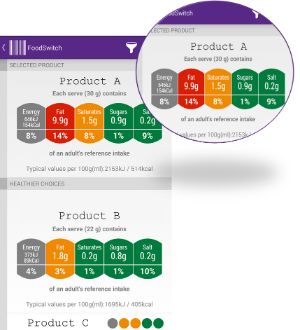Reading labels
About three quarters of the salt we eat is hidden in processed foods. Checking product labels when shopping is therefore a useful tool for working out how much salt you are eating.
You can find out if the food you buy for you and your family is high in salt by looking at the nutritional information on the label. Checking food labels allows you to compare brands, varieties and flavours of products and choose those that are lower in salt. Adding up the amount of salt in the products you eat throughout the day will give you an idea of how much salt you are eating.
Healthy choices - low salt shopping guide [PDF 28KB] to view our handy low salt shopping guide
Colour-coded labelling
The government launched a consistent style of front of pack nutrition labelling, and is currently being adopted by all major supermarkets in the UK. The new labelling system will combine colour-coding with nutritional information, making it much easier and quicker for us to check whether our food is low in calories, fat, saturated fat, sugar and salt.
Colour-coded labelling makes it easy to see at a glance if a product is high (red), medium (amber) or low (green) in certain nutrients, including salt. The amount of these nutrients in grams per serving is also stated. Products which are green can be eaten freely and amber products are usually fine but you should try to limit the number of red products that you eat.
Reference Intakes
Reference intakes (RI's) are general guidelines for the amount of certain nutrients (including salt) that you should not be exceeding in a day. RI's provide a useful indication of how a nutrient or amount of energy fits into you diet, but are not set out as targets. Particularly with salt, the RI is a maximum amount. If you are buying for children, remember that the RI for a child is far lower than for adults.
The percentage RI of a product will show how much of fat, salt, sugar and calories is in a 100g portion, while the colours give an at a glance guide of how healthy the food is. Where possible, aim for as many products with green values, and avoid anything in red.
Working out how much salt is in your food
When salt is given per portion, you will need to check the portion size stated on the packaging to see if this is similar to the amount that you or your child will actually eat. For example, a label may state that a portion is one quarter of the product but realistically you may eat the whole product. If this is the case you will need to work out how much salt is in the amount you are eating
When salt is only given per 100g, you will need to work out how much salt will be contained in a portion. You can do this by thinking about how much of the product you or your child will be eating in relation to both the pack size and 100g i.e. whether this is more or less than 100g. Look at the weight of the packet as a guide.
Step 1 – Calculate how much salt there is per gram by dividing the amount of salt per 100g by 100
Step 2 - Check the weight of a recommended portion as stated on the pack
Step 3 – Finally, work out how much salt there is per portion by multiplying the figures from step 2 and step 3
|
FoodSwitch
|




